07_实验记录常用英文表达句型
实验记录英文写作模板
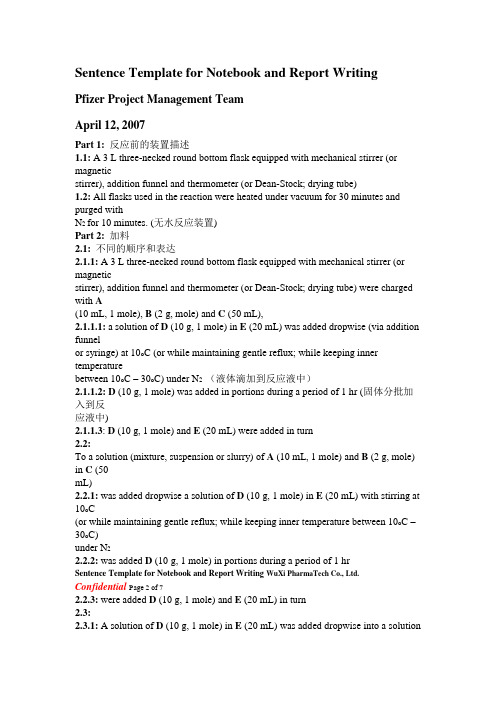
Sentence Template for Notebook and Report WritingPfizer Project Management TeamApril 12, 2007Part 1: 反应前的装置描述1.1: A 3 L three-necked round bottom flask equipped with mechanical stirrer (or magneticstirrer), addition funnel and thermometer (or Dean-Stock; drying tube)1.2: All flasks used in the reaction were heated under vacuum for 30 minutes and purged withN2 for 10 minutes. (无水反应装置)Part 2: 加料2.1: 不同的顺序和表达2.1.1: A 3 L three-necked round bottom flask equipped with mechanical stirrer (or magneticstirrer), addition funnel and thermometer (or Dean-Stock; drying tube) were charged with A(10 mL, 1 mole), B (2 g, mole) and C (50 mL),2.1.1.1: a solution of D (10 g, 1 mole) in E (20 mL) was added dropwise (via addition funnelor syringe) at 10o C (or while maintaining gentle reflux; while keeping inner temperaturebetween 10o C – 30o C) under N2 (液体滴加到反应液中)2.1.1.2: D (10 g, 1 mole) was added in portions during a period of 1 hr (固体分批加入到反应液中)2.1.1.3: D (10 g, 1 mole) and E (20 mL) were added in turn2.2:To a solution (mixture, suspension or slurry) of A (10 mL, 1 mole) and B (2 g, mole) in C (50mL)2.2.1: was added dropwise a solution of D (10 g, 1 mole) in E (20 mL) with stirring at 10o C(or while maintaining gentle reflux; while keeping inner temperature between 10o C –30o C)under N22.2.2: was added D (10 g, 1 mole) in portions during a period of 1 hrSentence Template for Notebook and Report Writing WuXiPharmaTech Co., Ltd.Confidential Page 2 of 72.2.3: were added D (10 g, 1 mole) and E (20 mL) in turn2.3:2.3.1: A solution of D (10 g, 1 mole) in E (20 mL) was added dropwise into a solution(mixture or suspension) of A (10 mL, 1 mole) and B (2 g, mole) in C (50 mL) at 10o C (orwhile maintaining gentle reflux; while keeping inner temperature between 10o C –30o C) underN22.3.2: D (10 g, 1 mole) was added into a solution (mixture or suspension) of A(10 mL, 1mole) and B (2 g, mole) in C (50 mL) in portions2.3.3: D (10 g, 1 mole) and E (20 mL) were added into a solution (mixture or suspension) ofA (10 mL, 1 mole) andB (2 g, mole) inC (50 mL) in turn2.4:2.4.1: A solution of BuLi or BH3/THF (10 mL, 1 mole, 2.5 M in hexane) was cannulated intoaddition funnel or into a solution A in solvent B2.4.2: A solution of BuLi or BH3/THF (10 mL, 1 mole, 2.5 M in hexane) was added into asolution of A in solvent B via cannula, dropping funnel or syringe over a period of hrs Part 3: 反应3.1: 无溶剂反应A (1 g, 1 mol) andB (1 g, 1 mol) were dissolved in solvent C, evaporated to dryness andheated for x hours at x o C3.2: 催化量的反应A (20 mL, 142 mmol) and catalytic amount (a trace amount or two drops) ofB were addedinto a solution of C (4.549 g, 46.4 mmol) in D(120mL) at 0 o C3.3: 闷罐反应或封管反应A solution of A(x g, x mol) in methanol (x mL) saturated with NH3 (or other gas such as: CO,CO2, H2S) was stirred under 50 Psi at x o C for x hours in a 50 mL of sealed tube or autoclave.Sentence Template for Notebook and Report Writing WuXiPharmaTech Co., Ltd.Confidential Page 3 of 73.4: 有气体参与的反应3.4.1: A solution of A (x g, x mol) in methanol (x mL) saturated with HCl was stirred at x ℃.3.4.2: Ozone was bubbled into a solution of A (x g, x mol) in MeOH (x mL) at x o C for 15minutes. After excess O3 was purged by N2, Me2S (x mL) was added at x o C.3.4.3: Gas was bubbled into a solution of A (x g, x mol) and B (x g, x mol) in solventC (xmL) at x o C for x hours.3.5: 混合溶剂参与的反应3.5.1: To a solution of A (x g, x mol) in a mixture of solvent B (mL) and solvent C (x mL) (ora mixed solvent of B and C) was added D (x g, x mol) at x o C, the reaction mixture wasallowed to stir (reflux or heat) for x hrs.3.5.2: To a solution of A (x g, x mol) in 10: 1 aqueous acetone (x mL) was added B (x g, xmol) followed by addition of C (x g, x mol), the reaction mixture was allowed to stir (refluxor heat) for x hrs.3.6: 分水器分水的反应3.6.1: A (x g, x mol) and B (x g, x mol) in benzene or toluene (x mL) were refluxed for xhours with azeotropical removal of water.3.6.2; A mixture of A, B and TsOH.H2O (56.91 g, 0.3 mol) in toluene (400 mL) was heated toreflux and remove water by Dean-Stark trap.3.7: 氢化反应To a solution of A (x g, x mol) in EtOH (x mL) was added Pd-C or Ra-Ni orPd(OH)2/C (10%,x g) under N2. The suspension was degassed under vacuum and purged with H2 several times.3.7.1: The mixture was stirred under H2 (x psi) at x ℃for x hours. [氢化瓶或高压釜] 3.7.2: The mixture was stirred under H2 balloon at x ℃for x hours. [常压氢化如气球反应]3.7.3: A mixture of A (x g, x mol) and Ra-Ni (x g) in EtOH (x mL) was hydrogenated under50 Psi of hydrogen pressure for x hours at room temperature.Sentence Template for Notebook and Report Writing WuXiPharmaTech Co., Ltd. Confidential Page 4 of 7Part 4: 反应条件或过程描述4.1: The reaction mixture (solution or suspension) was stirred at 5o C for 2 hrs and then kept atroom temperature (or ambient temperature) for another 2 hrs (or overnight)4.2: The reaction mixture (solution or suspension) was refluxed (heated to reflux) or heated at60o C for 2 hrs (or overnight)4.3: The reaction mixture (solution or suspension) was allowed to reflux (or heat to reflux) for2 hrs (or overnight)4.4: The reaction mixture (solution or suspension) was allowed to warm to temperature during2 hrs and reflux (or heat to reflux) for 2 hrs (or overnight)Part 5: 反应监测5.1: Taking sample from the reaction mixture (solution or suspension) by dropping tube orsyringe. After workup, check the reaction via TLC, LC-MS or HPLC etc.. (预处理) 5.2: 反应状态或终点描述5.2.1: The reaction was complete (incomplete or messy) detected (determined or confirmed)by TLC (PE/EtOAc 4:1), LC-MS, HPLC or NMR5.2.2: TLC (PE:EtOAc=1:1) or HPLC (107757-088-1) showed or indicated that the reactionwas complete.5.2.3: TLC (PE:EtOAc=1:1) or HPLC (107757-088-1) showed the starting material wasconsumed completely.5.2.4: TLC (PE:EA=1:1) or HPLC (107757-088-1) showed the reaction didn’t work at all ormost of starting material was still remained.5.2.5: The starting material was consumed completely, but no desired compound was detectedor determined by MS (106657-078-1) or LC-MS (106657-078-1).5.2.6: Several spots were shown on TLC.5.2.7: Only a trace amount of desired compound was detected by MS (106657-078-1) orLC-MS (106657-078-1) or HPLC (106657-078-1) or TLC (PE:EtOAc=1:1).5.2.8: The desired compound could not be isolated, separated or purified by chromatographyor prep. HPLC due to poor yield or poor solubility.Sentence Template for Notebook and Report Writing WuXiPharmaTech Co., Ltd. Confidential Page 5 of 75.2.9:1H NMR (106675-010-2) or MS confirmed the obtained (or isolated) compound is notthe desired compound. The reaction was failed.Part 6: 反应淬灭6.1: An aqueous solution of A (10 mL) was added dropwise into the reaction mixture once thereaction mixture (solution or suspension) was allowed to warm (or cool) to -5o C or roomtemperature (ambient temperature).6.2: The hot (or cold) reaction mixture (solution or suspension) was poured into water (icewater) or poured onto ice.6.3: The reaction mixture (solution or suspension) was concentrated (distilled) under reducedpressure (in vacuum) or evaporated to remove MeOH (THF; DMF etc.) or excess SOCl2(reagent). Then the reaction residue (or the residual) was diluted with solvent and poured intowater (ice water) or poured onto ice.Part 7: 分液提取7.1: The residue was partitioned between ethyl acetate (100 mL) and 1N aq. HCl (50 mL).The separated organic layer was washed with water, dried over (Na2SO4 or MgSO4) andevaporated to dryness.7.2: After quenching the reaction, the reaction mixture was poured into separatory funnel andseparated.7.3: The aqueous layer (or phase) was extracted with organic solvent (40 mL) twice (or Xtimes). The combined organic layers were (or the organic layers were combined and) washedwith an aqueous solution of A (50 mL) or water and dried over Na2SO4 or MgSO4.7.4: The combined aqueous layers were extracted with solvent (40 mL) twice (or X times) toremove neutral impurities. The aqueous phase was acidified (or basified) with aqueous HCl(or NaHCO3) till PH = X and extracted with organic solvent.7.5: The combined organic layers were (or the organic layers were combined and) washedwith an aqueous solution of A (50 mL) or water and dried over Na2SO4 or MgSO4. Sentence Template for Notebook and Report Writing WuXiPharmaTech Co., Ltd. Confidential Page 6 of 7Part 8: 浓缩蒸发8.1: After filtration via filter paper or Celite pad, the organic layer (or extract) was concentrated under reduced pressure (or in vacuum) or evaporated to dryness to provide(afford; give or yield) an oil (or foam) (which solidified on standing) or a white solid.8.2: The organic layer (or extract) was filtered and concentrated under reduced pressure (or invacuum) or evaporated to dryness to provide (afford or give) A (10 g, 0.5 mole) an oil (orfoam) (which solidified on standing) or a white solid.8.3: After removal of solvent by evaporation or concentration, A (10 g, 0.5 mole) was obtained (or prepared) an oil (or foam) (which solidified on standing) or a white solid.8.4: The extract in CH2Cl2 was evaporated to dryness and then swapped with toluene toremove residual CH2Cl2.Part 9: 几种常见的后处理描述9.1: The reaction mixture or solution was concentrated to dryness. [适用于反应液不需要quench]9.2: After the reaction mixture was cooled to 0 ℃, the reaction mixture was quenched byaddition of x mL of H2O, followed by x mL of 15% aqueous NaOH. After being stirred atroom temperature for x hour, the solid was removed by filtration (or the mixture was filteredthroughCelite pad to remove by-product). The filtrate was concentrated to dryness to givecrude product. [LiAlH4 反应的经典后处理]9.3: The mixture was diluted with water (x mL), neutralized with solid K2CO3 until no CO2was evolved. [适用于酸性反应液的后处理]9.4: The suspension was filtered through a pad of Celite or silica gel and the pad or filter cakewas washed with EtOH (x mL×x). The combined filtrates were concentrated to dryness togive product (x g, x%) as. [适用氢化反应的后处理, 或者难于过滤的反应液的后处理, 但要注意的是这里需要的是滤液而不是固体才能添加助滤剂]9.5: The reaction mixture was poured into x mL of ice-water carefully and the organic layer orphase was separated. [产物在有机相里]9.6: The reaction mixture was poured into x mL of ice-water carefully and the aqueous phasewas washed with Et2O (x mL×x) [产品在水相] and acidified with 1N HCl to pH=3. TheSentence Template for Notebook and Report Writing WuXiPharmaTech Co., Ltd. Confidential Page 7 of 7resulting precipitate was collected by filtration or the resulting solution was extracted with EA(x mL×x).9.7: The reaction mixture was filtered and the filter cake was washed with x mL of solvent,dried in vacuum to give or afford product. [这里需要的是固体而不是滤液]9.8: The reaction mixture was quenched with x mL of saturated aqueous NH4Cl. The resultingsolution was extracted with EA (x mL×x). [适用于丁基锂等活泼金属有机物的后处理]9.10: The residue was triturated with ether and filtered to afford a white solid. (磨碎) 9.11: The crude product was purified by prep. HPLC to give A as a colorless thick oil whichwas solidified on standing. (静止固化)9.12: After prep. HPLC purification, the eluent was concentrated or evaporated to removeorganic solvents. The residual aqueous solution was lyophilized to give a white solid. (冷冻干燥)9.13: After concentration, the crude product was used directly for the next step withoutpurification.Part 10: 产品的纯化10.1: The crude product was purified by silica gel chromatography eluted with PE: EtOAc=10:1 to give product (x g, x%) as yellow solid.10.2: The crude product was purified by re-crystallization (or re-crystallized) from x solvent(x mL).10.3: The crude product was distilled in vacuum (x o C, x pressure) to afford pure product (x g,x%) as colorless liquid.10.4: The crude product was pre-purified by column chromatography followed by prep.HPLC purification or re-crystallization to afford pure product.__。
常用实验英文

常用实验英文TTA standardization office【TTA 5AB- TTAK 08- TTA 2C】容器与耗材v e s s e l&c o n s u m a b l e m a t e r i a l?小瓶vial量杯measuring cup烧杯beaker量筒measuring flask/measuring cylinderer坩埚crucible坩埚钳crucible clamp试管test tube漏斗funnel比色皿cuvette鱼缸aquarium烧瓶flask锥形瓶conical flask塞子stopper/plug洗瓶plastic wash bottle玻璃活塞stopcock试剂瓶reagent bottles玻棒glass rod搅拌棒stirringrod容量瓶volumetric flask/measuring flask移液管(one-mark) pipette吸液管pipette滤器filter滤纸filter paper培养皿culture dish移液枪pipette移液枪枪头pipette tips剃刀刀片razorblade手术刀scalpel垃圾袋disposablebag垃圾桶garbagebin橡皮筋rubber band托盘Tray铝箔aluminiumfoil洗耳球rubber suction bulb 保鲜膜preservativefilm研磨钵mortar研杵pestle小滴管dropper蒸馏装置distillingapparatus 桶bucket广口瓶wide-mouth bottle 离心机转子rotor试管架test tube holder/rack 酒精灯alcoholburner酒精喷灯blastalcohol burner搅拌装置stirring device石蜡封口膜Parafilm微量离心管(EP管)Eppendorf tube 载玻片Slide盖玻片Cover glass离心管Centrifugetube电泳槽Geltank电线Electricalleads牙签Toothpick螺丝钉Screw锁紧螺母Nut,Cap nut复印纸Copypaper复写纸Carbonpaper钉Nail试管刷test-tube brush计时器Timer闹钟AlarmclockU形钉Staple衣服挂钩Coathanger电泳用的梳子Comb扳手Shiftingspanner订书机Stapler订书钉staple圆珠笔芯Refill灯泡Globe记号笔marker pen注射器syringe注射器活塞plunger铁架台ironsupport万能夹extensionclamp止水夹flatjawpinchcock圆形漏斗架cast-ironring橡胶管rubbertubing药匙labspoon镊子forceps/tweezers蜂鸣器buzzer架子shelf剪刀scissor打孔器stopperborer移液吸管serological pipette血球计数板hemocytometerpH试纸 universal ph indicatorpaper 称量纸weighingpaper透明胶带sellotape筛子sieve格子grid擦镜纸wiperfor lens水银温度计mercury-filled thermo meter 白大褂white gown真空泵vacuum pump水浴锅waterbath kettle口罩respirator电极electrode阳极,正极anode阴极,负极cathode实验操作(manipulation)丢弃discard转移容器decant吸出aspirate吹吸blowing and suction离心收集pellet重悬resuspend絮状沉淀flocculent precipitate浑浊的turbid烘bake灭菌sterilize均质化homogenize培养foster通风ventilate冷却chill down稀释dilute洗脱elute孵育incubate超声破碎ultrasonication 淬灭quench裂解物Lysate沉淀物Sediment上清Supernatant小滴droplet一批batch色谱chromatograph沉淀precipitate接种inoculate探针probe蒸馏distil/distill搅拌Stir/agitate旋转swirl/ spin中和neutralize校准calibrate平衡equilibrate结块、块状沉淀clump粘稠的viscous漂洗rinse脱水dehydrate发酵fermentation溶解dissolve燃烧combustion水解hydrolysis过滤filtrate浓缩condense催化剂catalyst研磨grind破碎crush催化作用catalysis分解dissolution涡旋震荡Vortex电泳Electrophoresis抽滤suctionfiltration电转化electro-transformation 收菌harvest切碎chop/mince灌注perfusion浆液slurry?仪器(apparatus)恒温循环仪Thermostatic circulator?空调机AirconditionerpH计pHmeter照度计(测量荧光素酶酶活)lumino meter 磁力搅拌器magnetic stirrer烘箱oven?微波炉microwave oven电磁炉electromagnetic oven凝胶系统Gel system电子天平Electronic balance转接器Adapter离心机centrifuge盖子lid/ cap封口设备Sealing equipment复印机Duplicator,copying machine 超净工作台superclean bench通风橱fume cup board药柜Cupboard高压蒸汽灭菌器autoclave电泳电源Electrophoresispower supply 紫外灯Ultravioletillumination真空泵Vacuum pump?天平balance/scale分析天平analytical balance台秤platform balance涡旋振荡器Vortexing machineCO2培养箱CO2 Incubators电子显微镜Electro Microscopy电泳仪Electrophoresis System恒流泵constantflow pump解剖镜anatomicallensPCR仪Thermocycler倒置显微镜Inverted Microscope核磁共振波谱仪NuclearMagnetic Resonance Spectrometer 光学显微镜Optical Microscopy摇床Shaker培养箱incubator超滤器Ultrahigh Purity Filter超低温冰箱Ultra-lowTemperature Freezer超声破碎仪UltrasonicCell Disruptor紫外观察灯UltravioletLamp紫外-可见光分光光度计UV-Visible Spectrophotometer计算器calculator/numerator化学试剂(reagent)1.氨基酸丙氨酸alanine(Ala, A)缬氨酸valine(Val, V)亮氨酸leucine(Leu, L)异亮氨酸isoleucine(Ile,I)脯氨酸proline(Pro, P)苯丙氨酸phenylalanine(Phe, F)色氨酸tryptophan(Trp, W)蛋氨酸methionine(Met, M)甘氨酸glycine(Gly, G)丝氨酸serine(Ser, S)苏氨酸threonine(Thr, T)半胱氨酸cysteine(Cys, C)酪氨酸tyrosine(Tyr, Y)天冬氨酸asparagines(Asn, N)谷氨酰胺glutamine(Gln, Q)赖氨酸lysine(Lys, K)精氨酸arginine(Arg, R)组氨酸histidine(His, H)天冬氨酸asparticacid (Asp, D)谷氨酸glutamicacid (Glu, E) 2.核苷酸腺苷adenosine?鸟嘌呤核苷guanosine?胞苷cytidine胸腺嘧啶脱氧核苷thymidine尿嘧啶核苷uridine脱氧deoxy-3.其他化学试剂二甲苯Xylene冰乙酸Aceticacid glacial硼酸Boricacid氯化钙Calcium chloride巯基乙醇mercapto ethanol咪唑Imidazole盐酸胍guanidinehydrochloride无水乙醇absoluteethanol乙酸钠Sodiumacetate氯化钠Sodiumchloride生理盐水physiologicalsaline洗涤剂detergent十二烷基磺酸钠Sodiumdodecyl sulphate 盐酸hydrochloricacid氢氧化钠sodiumhydrate/hydroxide胰蛋白胨Tryptone酵母提取物yeastextract琼脂Agar?甘油glycerin内毒素endotoxin两性霉素amphotericin氨苄Ampicillin肝素heparin卡那霉素Kanamycin胰蛋白酶Trypsin溴化乙锭ethidium bromide胰岛素Insulin树脂resin糖类saccharide蔗糖Sucrose醋酸钾Potassiumacetate异丙醇Isopropanol醋酸铵Ammoniumacetate异戊醇Isoamylalcohol氯仿Chloroform甲醇methanol遗传霉素geneticin糖原glycogen血清serum高锰酸钾potassiumhypermanganate考马斯亮蓝Coomassiebrilliant blue液氮liquidnitrogen次氯酸钠clorox苯酚phenol阴离子anion碱性alkalinity?实验室常用英语——化学生物类来美国学习遇到了一个很郁闷的事:走进实验室跟别人交流非常困难,自己做实验也是磕磕碰碰。
常用化学英语知识点归纳

常用化学英语知识点归纳化学英语是指在化学学科领域中所使用的英语词汇、表达方式以及相关知识点。
在化学实验、研究和教学等方面,化学英语扮演着重要的角色。
下面将详细介绍一些常用的化学英语知识点。
一、化学实验1. 实验室设备和器具的英文名称:- Beaker:烧杯- Test tube:试管- Flask:烧瓶- Burette:滴定管- Pipette:移液管- Distillation apparatus:蒸馏装置- Evaporating dish:蒸发皿- Crucible:坩埚- Bunsen burner:本生灯- Thermometer:温度计- Balance:天平2. 实验操作和步骤的常用表达方式:- Add:加入- Pour:倾倒- Mix:混合- Stir:搅拌- Heat:加热- Cool:冷却- Filter:过滤- Evaporate:蒸发- Precipitate:沉淀- Measure:测量- Weigh:称量- Calculate:计算- Record:记录3. 化学实验中常见的实验现象和结果的英文表达:- Change:变化- Reaction:反应- Reaction rate:反应速率- Precipitation:沉淀- Dissolve:溶解- Evaporation:蒸发- Combustion:燃烧- Oxidation:氧化- Reduction:还原- Color change:颜色变化- Gas formation:产生气体- Odor:气味- pH change:pH值变化二、化学元素和化合物1. 化学元素的英文名称:- Hydrogen:氢- Carbon:碳- Oxygen:氧- Nitrogen:氮- Sodium:钠- Potassium:钾- Iron:铁- Copper:铜- Gold:金- Silver:银2. 化合物的命名和表示方法:- Chemical formula:化学式- Molecular formula:分子式- Structural formula:结构式- Empirical formula:经验式- Ionic compound:离子化合物- Covalent compound:共价化合物- Organic compound:有机化合物- Inorganic compound:无机化合物- Acid:酸- Base:碱- Salt:盐3. 化学反应和方程式的表达方式:- Reactant:反应物- Product:产物- Chemical equation:化学方程式- Balanced equation:平衡方程式- Stoichiometry:化学计量- Catalyst:催化剂- Rate of reaction:反应速率- Equilibrium:平衡- Redox reaction:氧化还原反应- Acid-base reaction:酸碱反应- Combustion reaction:燃烧反应三、化学性质和分析方法1. 化学性质的英文表达:- Acidic:酸性的- Basic:碱性的- Alkaline:碱性的- Reactive:反应性的- Flammable:易燃的- Soluble:可溶解的- Insoluble:不溶解的- Stable:稳定的- Volatile:易挥发的- Toxic:有毒的2. 化学分析方法的英文名称:- Titration:滴定法- Spectroscopy:光谱分析- Chromatography:色谱法- Mass spectrometry:质谱分析- Electrochemistry:电化学分析- Atomic absorption spectroscopy:原子吸收光谱- Gas chromatography:气相色谱- High-performance liquid chromatography:高效液相色谱- Infrared spectroscopy:红外光谱- Nuclear magnetic resonance spectroscopy:核磁共振光谱四、物质计量和单位1. 常用的化学计量单位的英文缩写:- Gram:克- Milligram:毫克- Kilogram:千克- Liter:升- Milliliter:毫升- Microliter:微升- Moles:摩尔- Kilomoles:千摩尔- Atomic mass unit:原子质量单位- Molar mass:摩尔质量2. 温度、压力和浓度的英文表示方式:- Celsius:摄氏度- Kelvin:开尔文- Fahrenheit:华氏度- Pressure:压力- Atmosphere:大气压强- Pascal:帕斯卡- Concentration:浓度- Molarity:摩尔浓度- Mass concentration:质量浓度- Volume concentration:体积浓度以上只是化学英语知识点的一小部分,涵盖了化学实验、化学元素和化合物、化学性质和分析方法以及物质计量和单位等方面的内容。
英文常用的62个英语句型+你必须掌握的英语口语

~~~~~英文常用的62个英语句型句型1:There+be +主语+地点状语/ 时间状语There’s a boat in the river. 河里有条船.句型2:What’s wrong with+sb. / sth. ?What’s wrong with your watch?你的手表有什么毛病?句型3:How do you like...?How do you like China?你觉得中国怎么样?句型4:What do you like about...?What do you like about China?你喜欢中国的什么?句型5:had better(not)+动词原形You’d better ask that policeman over there. 你最好去问问那边的那个警察。
句型6:How+adj. / adv. +主语+谓语!What a/ an+adj. +n. +主语+谓语!How cold it is today !今天多冷啊!What a fine picture it is!多美的一幅图画呀!句型7:Thank+sb. +for(doing)sth.Thank you for coming to see me. 感谢你来看我。
句型8:So+be/ 情态动词/ 助动词+主语He is a student. So am I. 他是一个学生,我也是。
句型9:... not ... until ...He didn’t have supper until his parents came back. 直到他的父母回来他才吃饭。
句型10:比较级+and+比较级The baby cried harder and harder. 那孩子哭得越来越厉害。
句型11:the +比较级,the +比较级The more one has,the more one wants. 越有越贪。
实验英语常用英文表达
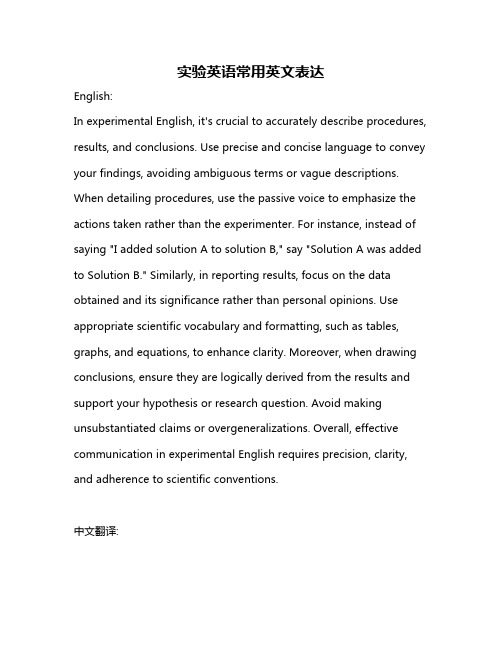
实验英语常用英文表达English:In experimental English, it's crucial to accurately describe procedures, results, and conclusions. Use precise and concise language to convey your findings, avoiding ambiguous terms or vague descriptions. When detailing procedures, use the passive voice to emphasize the actions taken rather than the experimenter. For instance, instead of saying "I added solution A to solution B," say "Solution A was added to Solution B." Similarly, in reporting results, focus on the data obtained and its significance rather than personal opinions. Use appropriate scientific vocabulary and formatting, such as tables, graphs, and equations, to enhance clarity. Moreover, when drawing conclusions, ensure they are logically derived from the results and support your hypothesis or research question. Avoid making unsubstantiated claims or overgeneralizations. Overall, effective communication in experimental English requires precision, clarity, and adherence to scientific conventions.中文翻译:在实验英语中,准确描述程序、结果和结论至关重要。
化学实验操作英语
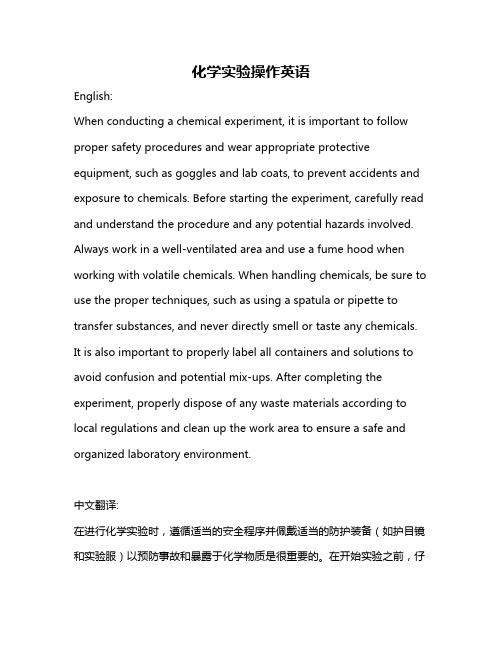
化学实验操作英语English:When conducting a chemical experiment, it is important to follow proper safety procedures and wear appropriate protective equipment, such as goggles and lab coats, to prevent accidents and exposure to chemicals. Before starting the experiment, carefully read and understand the procedure and any potential hazards involved. Always work in a well-ventilated area and use a fume hood when working with volatile chemicals. When handling chemicals, be sure to use the proper techniques, such as using a spatula or pipette to transfer substances, and never directly smell or taste any chemicals. It is also important to properly label all containers and solutions to avoid confusion and potential mix-ups. After completing the experiment, properly dispose of any waste materials according to local regulations and clean up the work area to ensure a safe and organized laboratory environment.中文翻译:在进行化学实验时,遵循适当的安全程序并佩戴适当的防护装备(如护目镜和实验服)以预防事故和暴露于化学物质是很重要的。
实验记录英语作文
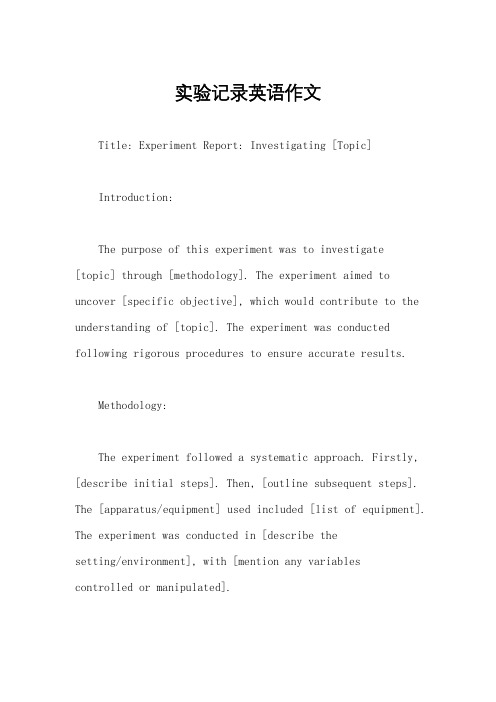
实验记录英语作文Title: Experiment Report: Investigating [Topic]Introduction:The purpose of this experiment was to investigate [topic] through [methodology]. The experiment aimed to uncover [specific objective], which would contribute to the understanding of [topic]. The experiment was conducted following rigorous procedures to ensure accurate results.Methodology:The experiment followed a systematic approach. Firstly, [describe initial steps]. Then, [outline subsequent steps]. The [apparatus/equipment] used included [list of equipment]. The experiment was conducted in [describe thesetting/environment], with [mention any variablescontrolled or manipulated].Results:The results obtained from the experiment wereconsistent with expectations. [Describe findings in detail]. These findings provide valuable insights into [topic] and align with previous research in the field. The datacollected was analyzed using [specific method], which confirmed [hypothesis or expectations].Discussion:The findings of the experiment suggest [interpretationof results]. This implies that [implications of findings]. Furthermore, the experiment encountered [mention any challenges or limitations], which may have influenced the results. However, steps were taken to mitigate these limitations, including [describe any corrective measures].Conclusion:In conclusion, the experiment successfully investigated [topic] and provided meaningful results. These findingscontribute to the existing knowledge on [topic] and offer potential avenues for further research. Overall, the experiment was conducted meticulously and yielded valuable insights into [topic].Future Directions:Moving forward, further research could explore [potential extensions or variations of the experiment]. Additionally, investigating [specific aspect related to topic] could deepen our understanding. Implementing [new techniques or methodologies] may also enhance future experiments in this field.Acknowledgments:I would like to acknowledge [mention any individuals or organizations] for their support and assistance throughout the experiment. Their contributions were invaluable to the success of this project.References:[Include any references or sources cited during the experiment].(Note: The actual content should be filled in according to your specific experiment and findings, avoiding direct prompts as requested.)。
英语作文常用句型总结
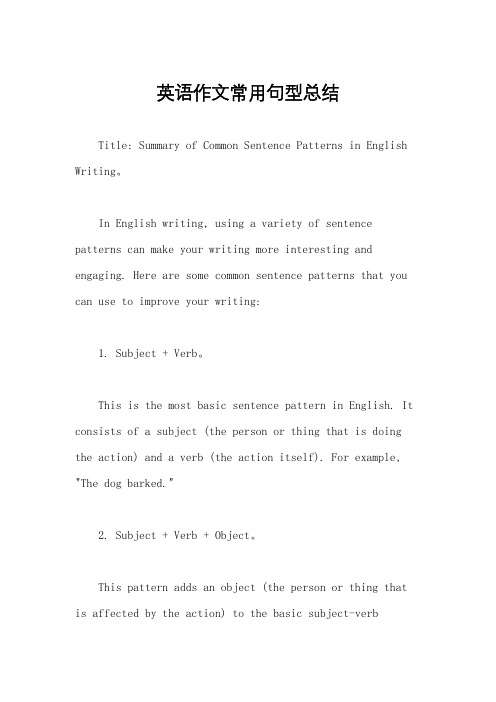
英语作文常用句型总结Title: Summary of Common Sentence Patterns in English Writing。
In English writing, using a variety of sentence patterns can make your writing more interesting and engaging. Here are some common sentence patterns that you can use to improve your writing:1. Subject + Verb。
This is the most basic sentence pattern in English. It consists of a subject (the person or thing that is doing the action) and a verb (the action itself). For example, "The dog barked."2. Subject + Verb + Object。
This pattern adds an object (the person or thing that is affected by the action) to the basic subject-verbpattern. For example, "She ate an apple."3. Subject + Verb + Complement。
In this pattern, the verb is followed by a complement, which provides more information about the subject. For example, "He is a doctor."4. Subject + Verb + Indirect Object + Direct Object。
- 1、下载文档前请自行甄别文档内容的完整性,平台不提供额外的编辑、内容补充、找答案等附加服务。
- 2、"仅部分预览"的文档,不可在线预览部分如存在完整性等问题,可反馈申请退款(可完整预览的文档不适用该条件!)。
- 3、如文档侵犯您的权益,请联系客服反馈,我们会尽快为您处理(人工客服工作时间:9:00-18:30)。
实验记录常用英文表达句型一、 加料过程常用表述1.添加试剂2.催化量的3.气体保护4.通入气体5.通过双针头导管加料6.通过注射器加料二、 反应过程常用表述1.反应检测2.放置过液3.甲苯/乙醇带水4.氢化反应5.分水器6.反应放热7.微波反应三、 后处理过程常用表述1.过滤2.淬火3.磨碎4.在两相中分开5.静止固化6.在冻干机冻干7.纯化过柱制备HPLC纯化制备TLC纯化重结晶8.调PH9.萃取10.浓缩11.干燥干燥真空干燥四、 部分常见反应现象描述1.加料放热2.反应过程中或者降温有固体析出3.加料不溶解4.反应变粘稠/变色五、 特殊结果叙述1.无进一步处理2.统一和其他批次一起后处理3.检测条件,不需要后处理一、加料过程常用表述1.添加试剂To a mixture (suspension / solution / slurry) of compound 12 (487 mg, 1 mmol) and o-plenylenediamine (948 mg, 6 mmol) in CH2Cl2 (15 ml) being coolen to 0℃ was added the DCC (226 mg, 1.1 mmol).Anhydrous lithium iodide (1.38 g, 10.3 mmol) was added the five portions (dropwise / in one portion / in portions) to a stirred solution of compound 12 (10.90 g, 51.5 mmol) in CH2Cl2 (120 ml).A round-bottom flask was changed with compound 3 (1.75 g, 5.27 mmol), LiCl (1.17 g, 26.3 mmol), DMSO (100 Ml) and H2O (378 ul)分批加入 in portions/portionwise一次性加入 in one portion滴加 dropwise2.催化量的Et3N (20 mL, 142 mmol) and a catalytic amount of DMAP were added the solution of compound 1 (4.549 g, 46.4 mmol) in CH2Cl2(120 ml) at 0℃3.气体保护To a stirred -78 solution℃of trimethylsilyacetylene (4.44g, 45.5 mmol)in THF (10 ml) under argon was added dropwise n-butylithium (1.6M in hexane, 28.25 ml).4.通入气体An ozone-enrichen steam of oxygen was bubbled through a cold (-78) solution of℃compound 9 (128 mg, 1.409 mmol) in CH2Cl2 (5 ml) until it turned light blue. The℃3 . solution was purged with argon at -78 for 10 min to remove the excess O5.通过双针头导管加料The mixture was added to a sulotion of compound 2 (3.00 g, 12.8 mmol) in THF (48 ml) via cannula over a period of 30 min.A solution of compound 29 (100 mg, 0.19 mmol, 1.0 equiv) in dry DMSO (1.5 ml) was cannulated under argon to a vigorously stirred mixture of powered potassium superoxide (62 mg, 0.87 mmol, 4.5 equiv) and 18-crown-6-ether (23 mg, 0.087 mmol, 0.45 equiv) in dry DMSO (0.5 ml).6.通过注射器加料To a stirred solution of compound 15 (8.61 g, 21.2 mmol) was added a solution of p-toluenesulfonic acid (6.0 g) in CH2Cl2 via syringe over 5 min.7. 反应控温A solution of compound 1 (10 g, 1 mol) in EtOAc (20 ml) was added dropwise (via addition funnel or syringe) to the above mixture at 10 ℃(while maintaining gentle reflux;℃.while keeping internal temperature between 10 ℃ - 30)二、反应过程常用表述1. 常温/回流搅拌℃a.The reaction mixture (solution or suspension) was stirred at 5 for 2 hrs andthen kept at room temperature (or ambient temperature) for another 2 hrs (or overnight)b.The reaction mixture (solution or suspension) was refluxed (or heated to reflux)for 2 hrs (or overnight)℃c.The reaction mixture (solution or suspension) was heated at 60 for 2 hrs (orovernight)d.The reaction mixture (solution or suspension) was allowed to reflux (or heat toreflux) for 2 hrs (or overnight)2. 反应检测a. After 1 h, TLC analysis (CH2Cl2 / hexane 3:1) showed the complete consumption of compound 15.b. The reaction was complete (incomplete or messy) detected by TLC (Petroleum ether/EtOAc = 4:1),LC-MS, HPLC or NMR.3. 放置/过夜The mixture was left standing overnight.The mixture was allowed to stand at room temperature for 1 day.℃The mixture was allowed to stand in a freezer at -15 .4. 甲苯/乙醇带水Compound A (1.97 g, 6.63 mmol) was coevaporated with toluene five times to remove the water. The residue was subjected to toluene azeotrope to give the corresponding acid choride as brown oil. The aqueous portion was concentrated under reduced pressure followed by azeotropic removal of water with absolute EtOH.5. 氢化反应A mixture of compound 1 (190 g, 0.88 mmol) and Raney Ni (20 g) in ethanol (1500 ml) and ethyl acetate (500 ml) was stirred under 1 atm at room temperature for an hour.6. 分水器A mixture of TsOH.H 2O (56.91 g. 0.3 mol) and toluene (400 mL) was heated to reflux to remove water by Dean-Stark trap.7. 反应放热 / 吸热The reaction was exothermic / endothermic .8. 微波反应The sealed vial was irradiated in the microwave on a Biotage Smith Synthesis at 150 for 10 min.℃9. 抽真空The mixture was degassed for 10 min and refilled with N .210. 吸收装置The device for absorbing the evolved hydrogen bromide was attched to the reaction flask. [care!! The reaction evolves HBr and is best connected to a HBr gas trap (bubber containing 1 M NaOH solution)].11.避光反应To the solution which is protected from light was added dropwise Br (3.45 g, 22 mmol) in CH 22Cl 2 (10 mL) over 5 min and the mixture was stirred for 1 h.A mixture of compound 8 (213 mg, 0.186 mmol) and compound 9 (220 mg, 0.279 mmol) was refluxed for 20h under dark in a nitrogen atmsophere.三、后处理过程常用表述1. 过滤The mixture was filtered through a Celite pad, and the filtrate was concentrated to give the crude product.2. 淬火The reaction mixture was quenched by the addition of the saturated aqueous NH4Cl. 3. 磨碎The residue was triturated with ether and filtered to afford a white solid.4. 分液After quenching the reaction, the reaction mixture was poured into separator funnel and separated.5. 在两相中分开The residue was partitioned between ethyl acetate (100 ml) and HCl (1N, 50 ml).The organic layer was washed with water, dried (MgSO4) and evaporated to dryness.Ethyl acetate (100 ml) and HCl(1 M aq, 50 mL)were added to the residue, and the layers were separated.6. 静止固化The crude product was purified by prep-HPLC to give compound 4 as colorless thick oil, which was solidfied on standing.7. 在冻干机冻干The white solid was re-crystallized from water, dried by hyophilization to give a white solid.7.纯化7.1 过柱The crude produt was chromatographed on silica gel (CH2Cl2 / MeOH 20:1→10:1→5:1) to give the compond 8 (0.282 g, 51%) as a white solid.The crude product was purified by column chromatography on silica gel eluted with (CH2Cl2 / MeOH 20:1→10:1→5:1) to give the compound 8 (0.282 g, 51%) as a white solid.7.2 制备HPLC纯化Be purified by prep-HPLC to afford/give/yield7.3 制备TLC纯化Be purified by prepare TLC to afford/give/yield7.4 重结晶Recrystallized from8.调PHThe pH was adjusted to around 9 by progressively adding solid NaHCO3.The mixture was adjusted to pH 9 with solid NaHCO3.酸化: be acidified to 碱化: be basified to 中和: be neutralized9.萃取The aqueous layer was extracted with ethyl acetate (100 mL×4).10.浓缩The mixture was evaporated to afford the crude product.The mixture was concentrated afford the crude product.The solvent was removed to afford the crude product.11.干燥11.1 常规干燥The organic layer was dried over , and concentrated.MgSO411.2 真空干燥The precipitate was filtered and dried (in/under vacumm; under reduced pressure).四、部分常见反应现象表述1.加料加热A gentle reflux appeared throughout the addition.The temperature was increased from 25℃to 50 during the addition.℃2.反应过程中或者降温有固体析出Solid was precipitate out after 1h reaction.℃The reaction mixture was cooled to -10, and solid was precipitate out.3.加料不溶解XX was added to the mixture, and the resulting suspension was stirred for 2h.4.加热溶解℃The suspension was heated to 90 and stirred until all solid was dissolved.5.反应变粘稠/变色The reaction mixture became sticky after 2hrs reaction/stirring.After 2hrs stirring, the mixture turned into black/brown/gray/yellow/red color.五、特殊结果叙述1.无进一步处理No further operation2.统一和其他批次一起后处理The work-up of this batch was together with the other batches that recorded in the following pages.3.检测条件,不需要后处理IPC check showed this condition is better/bad for this reaction. No further operation / screen reaction.Processs 组关于实验记录本内容方面的规范1. 反应时间要明确,统一规定为:XX(时): XX(分) 投料XX(时): XX(分) 检测XX(时): XX(分) 后处理XX(时): XX(分) 纯化及结果2. 反应必须有重要的反应现象叙述,包括物理现象和化学现象,比如放热,产生气体,产生沉淀,变粘稠,颜色变化等等。
